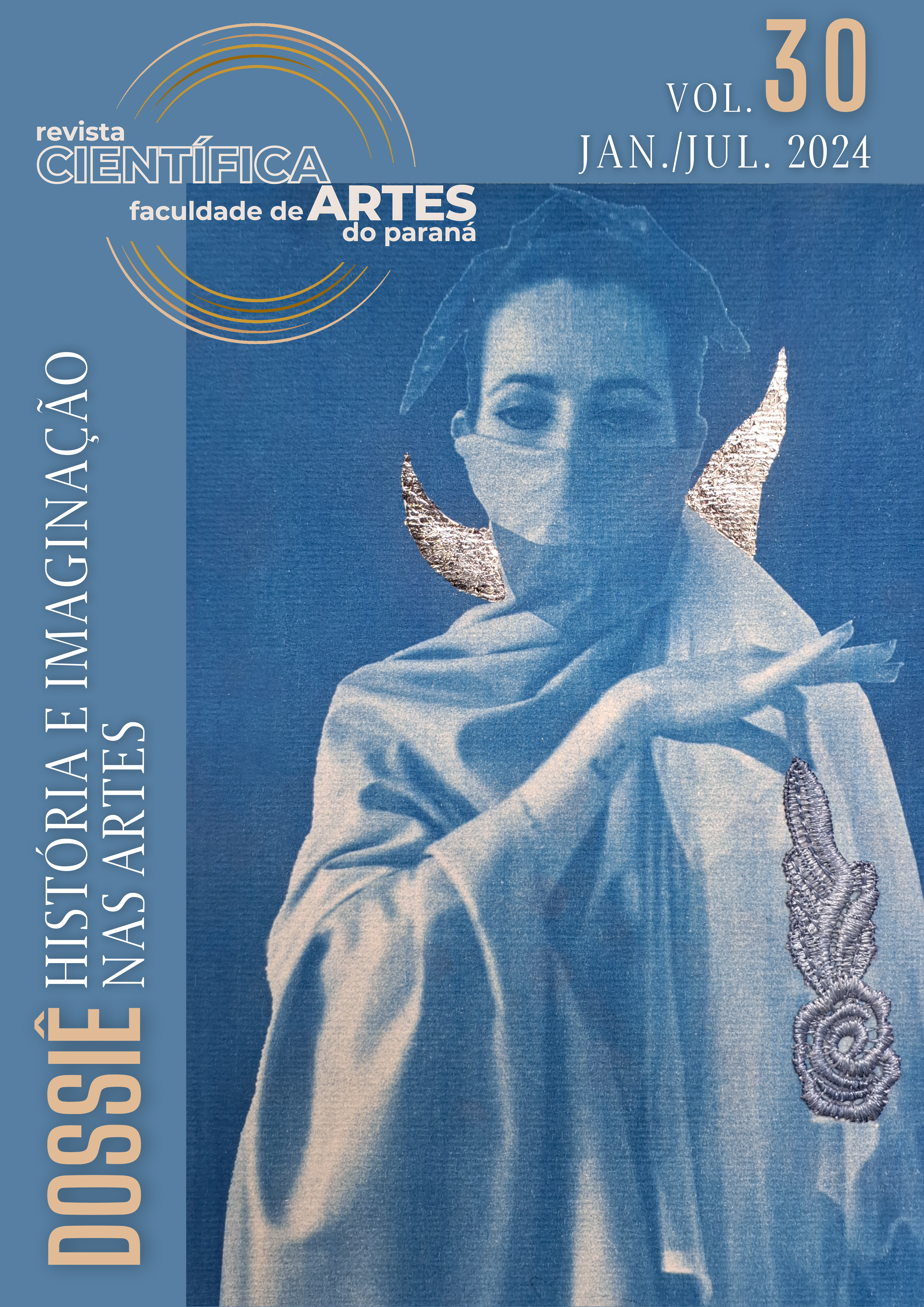The Journey Of Creating A [Video]Dance:
The Imagination And Educational Narrative Of A Body Between Virtual Screens And Windows
DOI:
https://doi.org/10.33871/19805071.2024.30.1.8768Keywords:
Video Arts, Videodance, Education, Body, ImaginationAbstract
This article focuses on the process of creating the work ‘EntreTelas - uma videoconfedança’ (2020) to reflect and analyze how and by what means videodance language, in its procedural formative aspects, and not just as an artistic result material, can also be considered as a methodological approach for teaching-learning in Dance in times of online mediation. As a theoretical basis, the text refers to some assumptions of the pedagogy of ubiquity and education for/in the digital era. For the area of Education, in times of pandemic and social isolation [2020-2022], the reflection intended here can contribute by proposing to point out hybrid forms of teaching-learning in [video]dance, creating structures for recording the process of creation and training and integrate participants, in their trajectories of learning dance movement, through advanced communication technologies. The protagonism of participants in their own creative processes, on digital networks, can ensure this collective performative act as a powerful space for the construction of virtualized bodies and artistic imaginaries.
Downloads
References
__________. EntreTelas: uma videoconfedança – YouTube , 2020. 1 vídeo (8 min). Disponível em: ___________ [autoria da obra e link suprimidos]. Acesso em: 13 fev. 2024.
ARAÚJO, Leonardo Vasconcelos. Quem dera ser um peixe: entre a tática e a estratégia. In: Interprogramas de Mestrado da Cásper Líbero, 11. 2016, São Paulo. Anais. São Paulo: Faculdade Cásper Líbero, 2016. p.1-13. Disponível em: https://static.casperlibero.edu.br/uploads/2017/02/Leonardo-Araújo-UFC.pdf. Acesso em: 13 jan. 2024.
CERTEAU, Michel de. A invenção do cotidiano: artes de fazer - vol. 1. Petrópolis: Vozes, 2014.
FERNANDES, António Teixeira. Para uma sociologia da cultura. Porto: Campo das Letras, 1999.
GUZZO, Marina Souza Lobo. Dança de Trisha Brown: heterotropia do corpo na cidade. In: BARRETO, Junia;
FADUL, Telmo. (Org.) Telalternativas. São Paulo: Horizonte, 2018. p. 98-107.
HAN, Byung-Chul. Hiperculturalidade: cultura e globalização. Petrópolis: Vozes, 2019.
LEMOS, André. Comunicação e práticas sociais no espaço urbano: as características dos Dispositivos Híbridos Móveis de Conexão Multirredes (DHMCM). Comunicação, mídia e consumo, São Paulo, v. 4, n. 10, p. 23-40, jul. 2007. Disponível em: https://revistacmc.espm.br/revistacmc/article/view/97. Acesso em: 30 jan. 2024.
MARQUES, Marcelo Souza. Críticas al modelo jerarquizado de cultura: por un proyecto de democracia cultural para las políticas culturales públicas. Rev. Estud. Soc., Bogotá, n. 53, p. 43-51, jul. 2015. Disponível em: https://journals.openedition.org/revestudsoc/9240. Acesso em 08 fev. 2024.
MOREIRA, José. António; SCHLEMMER, Eliane. Por um Novo Conceito e Paradigma da Educação Digital OnLife. Revista UFG - Revista da Universidade Federal de Goiás. Goiás, v.20, n.1, p. 1-35, 2020. Disponível em: https://revistas.ufg.br/revistaufg/article/view/63438. Acesso em: 03 fev. 2024.
RANCIÈRE, Jacques. O Espectador Emancipado. São Paulo: Editora WMF Martins Fontes, 2012.
ROCHA, Thereza. O que é dança contemporânea: uma aprendizagem e um livro de prazeres. Fortaleza: Conexões Criativas, 2016.
SALLES, Cecília de Almeida. Artistic creation as semiotic process: the esthetic lure of final causes. Semiotica - Journal of the International Association for Semiotic Studies – Nº 102 (3/4), 1994, p. 225-235. Disponível em: https://www.academia.edu/7779337/Creation_as_a_semiotic_process. Acesso em 02 jan. 2024.
SALLES, Cecília de Almeida. Gesto inacabado: processo de criação artística. 6.ed. São Paulo: Intermeios, 2013.
SALLES, Cecília de Almeida; ANASTÁCIO, Maria Guerra (Org.). A diversidade dos estudos de processo no século XXI. Salvador: EDUFBA, 2017.
SANTAELLA, Lucia. Navegar no ciberespaço: o perfil cognitivo do leito imersivo. São Paulo: Paulus, 2004.
SANTAELLA, Lucia. Linguagens líquidas na era da mobilidade. São Paulo: Paulus, 2007.
SANTAELLA, Lucia. Comunicação ubíqua: repercussões na cultura e na educação. São Paulo: Paulus, 2013.
SANTANA, Ivani. Dança na Cultura Digital. Salvador: EDUFBA, 2006.
SIEDLER, Elke. Redesenhos políticos do corpo: uma análise dos meios de circulação e concepção da dança on e off-line. 2016. 102 f. Tese (Doutorado em Comunicação e Semiótica) - Setor de Comunicação, Pontifícia Universidade Católica de São Paulo, São Paulo, 2016. Disponível em: https://tede2.pucsp.br/handle/handle/19137. Acesso em: 24 jan. 2024.
SOUZA E SILVA, Adriana. Do cíber ao híbrido. Tecnologias móveis como interfaces de espaços híbridos. In: ARAÚJO, D. (Org.). Imagem (Ir)realidade – comunicação e cibermídia. Porto Alegre: Ed. Sulina, 2006, p. 21-51.
TRIDAPALLI, Gladistoni dos Santos. Aprender Investigando: a educação em dança é criação compartilhada. 2008. 96 f. Dissertação (Mestrado em Dança) – Universidade Federal do Bahia (UFBA), Salvador, 2008. Acesso em: https://repositorio.ufba.br/bitstream/ri/8299/1/Dissertacao%20Gladistoni%20dos%20Santos%20Tridapalliseg.pdf. Acesso em: 10 fev. 2024.
WOSNIAK, Cristiane. O corpo e as midi(ações) tecnológicas na emergência de novas subjetividades para a dança em ambientes digitais. Anais do XIV Congresso de Ciências da Comunicação/ Intercom – região Sul, 2013. Disponível em: https://portalintercom.org.br/anais/sul2013/resumos/R35-0446-1.pdf. Acesso em: 03 fev. 2024.
WOSNIAK, Cristiane. A Educação, a Dança e a Pedagogia da Ubiquidade: reflexões sobre o corpo [e]m ações [vídeo]dançantes. In: GONÇALVES, J. C; GARANHANI, M. C; GONÇALVES, M. B. Linguagem, corpo e estética na educação. São Paulo: Hucitec, 2020. p. 125-14.
Downloads
Published
How to Cite
Issue
Section
License
The authors retain the copyright, when licensing their production in Revista Científica/FAP, which is licensed under a Creative Commons license. When submitting the article, and upon acceptance, the author assigns his copyright for publication in that journal.
Readers can download, print and use the articles published in the journal, as long as there is always an explicit mention of the author (s) and the Revista Científica/FAP, no changes to the original work are allowed. When submitting an article to Revista Científica/FAP and after its being accepted for publication, the authors allow, without remuneration, to pass the following rights to the Journal: the first edition rights and the authorization for the editorial team to transfer, according to their judgment, this article and its metadata to indexing and reference services.


